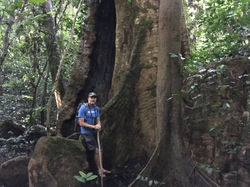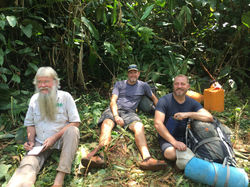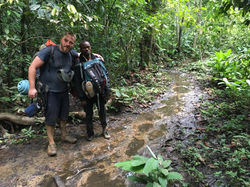
EXPEDITION WILD

Dzanga Sangha National Park, Central African Republic
Exploring the vast and remote equatorial region, the last outpost.
Expedition Basics:
Dates: Late October 2017
Total length of trip: 9 days.
Estimated distance: 10km - 16km/ day
Altitude: 350m to 600m
Getting there: Fly from JHB South Africa to Nairobi, Kenya then connect to Banqui, CAR and connect via light aircraft to Bayanga
Getting Back: Same as getting there.
Equipment Needed: A bottle of Whiskey for Rod, and all our own walking/ trail equipment and food.
Overview:
We where fortunately enough have conservationists Rod and Tamar Cassidy from Sangha Lodge who assisted us in putting this trip together. Rod is the man, and if you are heading into the deep darkest Congo he's your man for sure. But seriously this region is one of the least explored wildernesses areas on the continent and having explored more than most, I have to say this is the first place I have ever been too that honestly still represents a fully intact ecosystem as it was 100, 1000 years ago, absolutely incredible.
We flew for an hour over forest, no roads, houses, no visible human impact for as far as the eye could see, the rivers move with such force a 1000km from the ocean, but only 400m above sea level?, its then you begin to understand the power behind one of the largest oxygen factories on the planet.
The mighty Congo basin is there, go see it before its too late.
 |  |  |
|---|---|---|
 |  |  |
 |  |  |
Dzanga Sangha :
Dzanga Sangha National Park is part of a greater conservation initiative the Sangha River Tri-National Protected Area that traverses three countries namely Central African Republic, Cameroon and the Republic of Congo also referred to Brazzaville Congo. This region has been identified as a biological hotspot for its high density of large mammals, including Forest Elephants, Lowland Gorillas, Chimpanzee’s, Forest Buffalo, Bongo, Red River hogs, Giant Forest Hogs and a huge diversity of other smaller mammals, reptiles and birds but also for is botanical diversity most spectacularly displayed by the giants of all giants, the trees, that tower 60 – 70m above the forest floor and spread there canopies over thousands of square km’s creating this tropical wilderness.
One characteristic of this area that has drawn wildlife enthusiasts and some of the world’s leading behavioural scientist is the open forest clearings or Bai, where large groups of animals congregate at times. The mineral rich soil draws animals far and wide, but its Dzanga Bai that stands out amongst the rest and its home to the longest ongoing elephant research project on the continent initiated by Andrea Turkalo in 1990, who has over the past 27 years recorded just under 4000 individual elephants, some regular visitors, some infrequent and then the few ghosts that seem to disappear for years, to where no one knows, only to reappear years later, the mystery continues
 |  |  |
|---|---|---|
 |  |  |
 |  |  |
 |  |
The fruits of our labour :
With Sangha Lodge as our base we set out to explore the area, Dzanga Bai a short drive from the lodge and a small trek into the forest brings you to a elevated viewing platform where we spent the day viewing the bai that at times had over a 100 elephants going about there daily business, but we where also fortunate enough to see bongo, forest buffalo, and numerous birds including the crowned eagle which seem to be as common as pigeons, which I believe there is only one local species.
Next was Bai Hokou, deep in the forest to an isolated research post dedicated to studying a number of groups of Lowland Gorillas. Habituation of the first group started back in 1997, and we where fortunate enough to spend time with the Makumba group now well know for the "twins" born in early 2016. Habituation of this group started back in 2000 but then opened to visitors in 2005.
We climbed tree's, journeyed up river but this was preparation for our main adventure, walking the forest! Sangha Lodge assisted us with a guide and a local BaAka tracker for a 3 day trail into the forest, both their knowledge and bush skills where exceptional and again thanks to Rod for arranging everything. The going was not bad as we followed well uses elephant paths through the forest. This is an excellent walking trails destination and we where lucky enough to see forest elephants on many occasions (they are everywhere), bongo, red river hogs, chimps fleetingly but just exploring the many open clearings, trees, streams, bird life, insects (not as many as you think! for the squeamish), mushrooms and everything else made for an adventure of a lifetime.
We will be going back, and nothing seems to match sleeping on the ground miles away from anything familiar to bring you back to earth! The place we think we live.
 |  |  |
|---|---|---|
 |  |  |
 |  |  |
 |  |  |
 |  |  |
 |  |